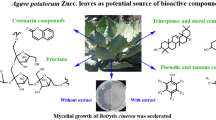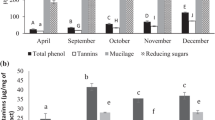Abstract
In recent years, agricultural waste materials and wild plants have become alternative raw materials for the source of bioactive components. This study included the data from antioxidant capacity (DPPH, ABTS, CUPRAC, FRAP, phosphomolybdenum, and metal chelating) and enzyme inhibitory assays (cholinesterase, tyrosinase, α-amylase, and α-glucosidase) on Gossypium hirsutum L. stalk extracts as well as HPLC technique. Flavonoid contents of the extracts were found to be low, while the amounts of phenolics were found as 14.38 and 13.22 µmol gallic acid equivalents (GAEs)/g dry plant (dp) in the methanolic and aqueous extracts, respectively. The extracts were determined to contain significant amounts of apigenin, quercetin, (−)-epicatechin, and protocatechuic acid. The extracts exhibited remarkable antioxidant activity almost in all tests. In addition, the methanolic and aqueous extracts showed promising inhibitory activity on α-glucosidase. Phenolics, in particular, p-hydroxybenzoic and benzoic acids, were found to be in correlation with the activities of the extracts. It was concluded that the stalk, which is the post-harvest field trash of the cotton cultivation, is an alternative source of bioactive molecules and can be used in pharmaceutical and food industries for its anti-diabetic and antioxidant activities.
Similar content being viewed by others
References
Avci U, Pattathil S, Singh B, Brown VL, Hahn MG, Haigler CH (2013) Cotton fiber cell walls of Gossypium hirsutum and Gossypium barbadense have differences related to loosely-bound xyloglucan. PLoS ONE 8(2):e56315
Egbuta MA, McIntosh S, Waters DLE, Vancov T, Liu L (2017) Biological importance of cotton by-products relative to chemical constituents of the cotton plant. Molecules. https://doi.org/10.3390/molecules22010093
Liu CX, Yuan DJ, Zhang XL, Lin ZX (2013) Isolation, characterization and mapping of genes differentially expressed during fibre development between Gossypium hirsutum and G. barbadense by cDNA-SRAP. J Genet 92(2):175–181
Sawan ZM, Hanna LI, El Karim GAG, McCuistion WL (2002) Relationships between climatic factors and flower and boll production in Egyptian cotton (Gossypium barbadense). J Arid Environ 52(4):499–516
Wendel JF, Brubaker CL, Seelanan T (1986) The origin and evolution of Gossypium. In: Mauney JR, Stewart JM (eds) Cotton physiology. The Cotton Foundation, Memphis, pp 1–18
Wu Z, Soliman K, Zipf A, Saha S, Sharma G, Jenkins J (2005) Isolation and characterization of genes differentially expressed in fiber of Gossypium barbadense L. J Cotton Sci 9:166–174
The Statistics Portal (2013) Statistica World’s 10 leading cotton producing countries in 2013/2104 (in metric tons). http://www.statista.com/statistics/263055/cotton-production-worldwide-by-top-countries/. Accessed 22 April 2015
Ferrandez-Garcia MT, Ferrandez-García CE, Andreu-Rodriguez J, Ferrandez-Villena M, Garcia-Ortuño T (2013) The suitability of utilising cotton stalk for low cost binderless panels. In: Actual tasks on agricultural engineering. Proceedings of the 41, international symposium on agricultural engineering, Opatija, Croatia, February 19–22 2013. University of Zagreb Faculty of Agriculture, pp 383–387
Guler C, Ozen R (2004) Some properties of particleboards made from cotton stalks (Gossypium hirsitum L.). Holz Roh Werkst 62(1):40–43
Yasar S, Icel B (2016) Alkali modification of cotton (Gossypium hirsutum L.) stalks and its effect on properties of produced particleboards. Bioresources 11(3):7191–7204
Fidan MS, Alma MH, Bektas I (2010) Liquefaction of cotton stalks (Gossypium hirsutum L.) with phenol. Wood Res 55(2):71–80
Shi J, Sharma-Shivappa RR, Chinn M, Howell N (2009) Effect of microbial pretreatment on enzymatic hydrolysis and fermentation of cotton stalks for ethanol production. Biomass Bioenerg 33(1):88–96
Coates W (2000) Using cotton plant residue to produce briquettes. Biomass Bioenerg 18(3):201–208
Tutus A, Ezici AC, Ates S (2010) Chemical, morphological and anatomical properties and evaluation of cotton stalks (Gossypium hirsutum L.) in pulp industry. Sci Res Essays 5(12):1553–1560
Bell AA (1986) Physiology of secondary products. In: Mauney JR, Stewart JM (eds) Cotton physiology. The Cotton Foundation, Memphis, pp 597–621
Essien EE, Aboaba SO, Ogunwande IA (2011) Constituents and antimicrobial properties of the leaf essential oil of Gossypium barbadense (Linn.). J Med Plants Res 5(5):702–705
Hu GJ, Houston NL, Pathak D, Schmidt L, Thelen JJ, Wendel JF (2011) Genomically biased accumulation of seed storage proteins in allopolyploid cotton. Genetics 189(3):U1103–U1602
Perveen SS, Qaisrani T, Bhutta S, Perveen R, Naqvi S (2001) HPLC analysis of cotton phenols and their contribution in bollworm resistance. Online J Biol Sci 1:587–590
Perveen SS, Qaisrani T, Siddiqui F, Perveen R, Naqvi S (2001) Cotton plant volatiles and insect’s behavior. Pak J Biol Sci 4(5):554–558
Shakhidoyatov KM, Rashkes A, Khidyrova N (1997) Components of cottonplant leaves, their functional role and biological activity. Chem Nat Compd 33(6):605–616
Banthorpe DV, Charlwood BV, Francis MJO (1972) Biosynthesis of monoterpenes. Chem Rev 72(2):115–155
Chizzola R (2013) Regular monoterpenes and sesquiterpenes (essential oils). In: Ramawat KG, Mérillon JM (eds) Natural products. Springer, Berlin, pp 2973–3008
Pare PW, Tumlinson JH (1997) De novo biosynthesis of volatiles induced by insect herbivory in cotton plants. Plant Physiol 114(4):1161–1167
Loughrin JH, Manukian A, Heath RR, Turlings T, Tumlinson JH (1994) Diurnal cycle of emission of induced volatile terpenoids by herbivore-injured cotton plant. Proc Natl Acad Sci 91(25):11836–11840
Moraes TM, Kushima H, Moleiro FC, Santos RC, Rocha LRM, Marques MO, Vilegas W, Hiruma-Lima CA (2009) Effects of limonene and essential oil from Citrus aurantium on gastric mucosa: role of prostaglandins and gastric mucus secretion. Chem Biol Interact 180(3):499–505
Dowd MK, Boykin DL, Meredith WR Jr, Campbell BT, Bourland FM, Gannaway JR, Glass KM, Zhang J (2010) Fatty acid profiles of cottonseed genotypes from the national cotton variety trials. J Cotton Sci 14:64–73
Haleem N, Arshad M, Shahid M, Tahir MA (2014) Synthesis of carboxymethyl cellulose from waste of cotton ginning industry. Carbohyd Polym 113:249–255
Ivanova I, Turakhozhaev M, Shakirov T (1984) Isolation of raffinose from cottonseed meal. Chem Nat Compd 20(6):657–660
John ME, Keller G (1995) Characterization of mRNA for a proline-rich protein of cotton fiber. Plant Physiol 108(2):669–676
King EE, Leffler HR (1979) Nature and patterns of proteins during cotton seed development. Plant Physiol 63(2):260–263
Kuo TM, Vanmiddlesworth JF, Wolf WJ (1988) Content of raffinose oligosaccharides and sucrose in various plant seeds. J Agr Food Chem 36(1):32–36
Xu WL, Zhang DJ, Wu YF, Qin LX, Huang GQ, Li J, Li L, Li XB (2013) Cotton PRP5 gene encoding a proline-rich protein is involved in fiber development. Plant Mol Biol 82(4–5):353–365
Mocan A, Vodnar DC, Vlase L, Crișan O, Gheldiu A-M, Crișan G (2015) Phytochemical characterization of Veronica officinalis L., V. teucrium L. and V. orchidea Crantz from Romania and their antioxidant and antimicrobial properties. Int J Mol Sci 16(9):21109–21127
Mocan A, Zengin G, Simirgiotis M, Schafberg M, Mollica A, Vodnar DC, Crişan G, Rohn S (2017) Functional constituents of wild and cultivated Goji (L. barbarum L.) leaves: phytochemical characterization, biological profile, and computational studies. J Enzym Inhib Med Chem 32(1):153–168
Mocan A, Zengin G, Uysal A, Gunes E, Mollica A, Degirmenci NS, Alpsoy L, Aktumsek A (2016) Biological and chemical insights of Morina persica L.: a source of bioactive compounds with multifunctional properties. J Funct Foods 25:94–109
Savran A, Zengin G, Aktumsek A, Mocan A, Glamoćlija J, Ćirić A, Soković M (2016) Phenolic compounds and biological effects of edible Rumex scutatus and Pseudosempervivum sempervivum: potential sources of natural agents with health benefits. Food Funct 7(7):3252–3262
Zengin G, Uysal A, Aktumsek A, Mocan A, Mollica A, Locatelli M, Custodio L, Neng NR, Nogueira JM, Aumeeruddy-Elalfi Z (2017) Euphorbia denticulata Lam.: a promising source of phyto-pharmaceuticals for the development of novel functional formulations. Biomed Pharmacother 87:27–36
Zengin G, Sarikurkcu C, Aktumsek A, Ceylan R, Ceylan O (2014) A comprehensive study on phytochemical characterization of Haplophyllum myrtifolium Boiss. endemic to Turkey and its inhibitory potential against key enzymes involved in Alzheimer, skin diseases and type II diabetes. Ind Crop Prod 53:244–251
Sarikurkcu C, Uren MC, Tepe B, Cengiz M, Kocak MS (2014) Phenolic content, enzyme inhibitory and antioxidative activity potentials of Phlomis nissolii and P. pungens var. pungens. Ind Crop Prod 62:333–340
Apak R, Guclu K, Ozyurek M, Karademir SE, Ercag E (2006) The cupric ion reducing antioxidant capacity and polyphenolic content of some herbal teas. Int J Food Sci Nutr 57(5–6):292–304
Tepe B, Sarikurkcu C, Berk S, Alim A, Akpulat HA (2011) Chemical composition, radical scavenging and antimicrobial activity of the essential oils of Thymus boveii and Thymus hyemalis. J Nat Prod 5(3):208
Sarikurkcu C, Tepe B, Kocak MS, Uren MC (2015) Metal concentration and antioxidant activity of edible mushrooms from Turkey. Food Chem 175:549–555
Zengin G, Sarikurkcu C, Gunes E, Uysal A, Ceylan R, Uysal S, Gungor H, Aktumsek A (2015) Two Ganoderma species: profiling of phenolic compounds by HPLC–DAD, antioxidant, antimicrobial and inhibitory activities on key enzymes linked to diabetes mellitus, Alzheimer’s disease and skin disorders. Food Funct 6(8):2794–2802
Sarikurkcu C (2011) Antioxidant activities of solvent extracts from endemic Cyclamen mirabile Hildebr. tubers and leaves. Afr J Biotechnol 10(5):831–839
Sarikurkcu C, Eryigit F, Cengiz M, Tepe B, Cakir A, Mete E (2012) Screening of the antioxidant activity of the essential oil and methanol extract of Mentha pulegium L. from Turkey. Spectrosc Lett 45(5):352–358
Opitz S, Kunert G, Gershenzon J (2008) Increased terpenoid accumulation in cotton (Gossypium hirsutum) foliage is a general wound response. J Chem Ecol 34(4):508–522
Opitz S, Nes WD, Gershenzon J (2014) Both methylerythritol phosphate and mevalonate pathways contribute to biosynthesis of each of the major isoprenoid classes in young cotton seedlings. Phytochemistry 98:110–119
Han XZ, Shen T, Lou HX (2007) Dietary polyphenols and their biological significance. Int J Mol Sci 8(9):950–988
Huang WY, Cai YZ, Zhang YB (2010) Natural phenolic compounds from medicinal herbs and dietary plants: potential use for cancer prevention. Nutr Cancer 62(1):1–20
Santos BCS, Silva JJM, Gasparetto CM, Chibli LA, Rodrigues KCM, Del-Vechio-Vieira G, Alves MS, Sousa OV (2014) Antioxidant potential of Gossypium hirsutum L. (Malvaceae) using DPPH, ferric reducing antioxidant power, beta-carotene bleaching and bioautography assays. Planta Med 80(16):1403–1403
Zhao YX, Dou J, Wu T, Aisa HA (2013) Investigating the antioxidant and acetylcholinesterase inhibition activities of Gossypium herbaceam. Molecules 18(1):951–962
Annan K, Houghton PJ (2008) Antibacterial, antioxidant and fibroblast growth stimulation of aqueous extracts of Ficus asperifolia Miq. and Gossypium arboreum L., wound-healing plants of Ghana. J Ethnopharmacol 119(1):141–144
Locatelli M, Zengin G, Uysal A, Carradori S, De Luca E, Bellagamba G, Aktumsek A, Lazarova I (2017) Multicomponent pattern and biological activities of seven Asphodeline taxa: potential sources of natural-functional ingredients for bioactive formulations. J Enzym Inhib Med Chem 32(1):60–67
Nagatsu A, Zhang HL, Mizukami H, Okuyama H, Sakakibara J, Tokuda H, Nishino H (2000) Tyrosinase inhibitory and anti-tumor promoting activities of compounds isolated from safflower (Carthamus tinctorius L.) and cotton (Gossypium hirsutum L.) oil cakes. Nat Prod Lett 14(3):153–158
Kazeem MI, Abimbola SG, Ashafa AOT (2013) Inhibitory potential of Gossypium arboreum leaf extracts on diabetes key enzymes, alpha-amylase and alpha-glucosidase. Bangl J Pharmacol 8(2):149–155
Rifat-uz-Zaman, Ghaffar M (2017) Anti-diabetic and hypolipidemic effects of extract from the seed of Gossypium herbaceum L. in Alloxan-induced diabetic rabbits. Pak J Pharm Sci 30(1):75–86
Acknowledgements
This research was supported by the Scientific Research Council of Suleyman Demirel University, Isparta-Turkey under Project No. 1592-D-07.
Author information
Authors and Affiliations
Corresponding author
Ethics declarations
Conflict of interest
The authors declare that they have no conflict of interest.
Research involving human and animal rights
This article does not contain any studies with human or animal subjects.
Electronic supplementary material
Below is the link to the electronic supplementary material.
Rights and permissions
About this article
Cite this article
Kirkan, B., Sarikurkcu, C., Copuroglu, M. et al. Is it possible to use the stalks of Gossypium hirsitum L., an important by-product of cotton cultivation, as an alternative source of bioactive components?. Eur Food Res Technol 244, 1065–1071 (2018). https://doi.org/10.1007/s00217-017-3029-5
Received:
Revised:
Accepted:
Published:
Issue Date:
DOI: https://doi.org/10.1007/s00217-017-3029-5




